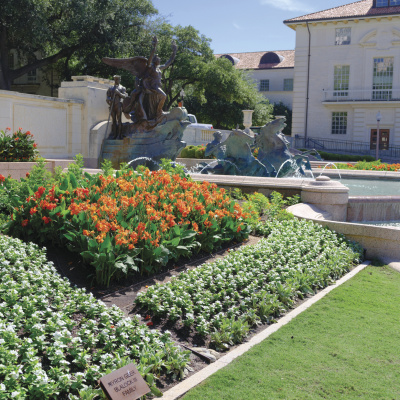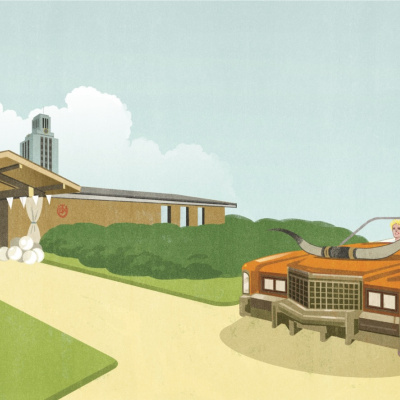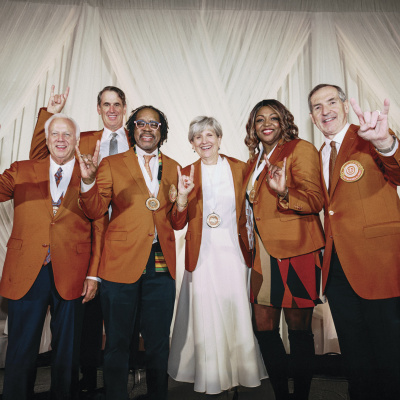A Texas Exes Host Shares the Unpredictable Awe of His Flying Longhorns Trip

At 5 a.m. on the last day of our Flying Longhorns trip through southern Africa, Thando—our kind, fun, and knowledgeable safari guide—stated with enthusiasm that we would find a leopard today.
Maybe it was the early morning or the lack of coffee, but I had given up on seeing a leopard. In fact, I almost liked the idea of not seeing one. In a world where most questions can be answered by a quick Google search and spontaneity is basically nonexistent, I find real pleasure in knowing that nature is still wild and unpredictable.
As a tour group, we had already seen four of the Big Five safari animals—lions, elephants, African buffalos, and rhinos—not to mention a plethora of other fascinating plants, birds, reptiles, insects, and mammals. Seeing a leopard would put a nice bow on the trip, but it might also feel a little too curated, maybe even a little unnatural.

The trip had started 12 days earlier at the Cape of Good Hope, which feels like the end of the world, or at least the end of the continent. It holds in its breathtaking landscape a natural and cultural history so rich and complicated that, as a guest, I felt sheepish taking a photo in front of a very photogenic sign. (But I did it anyway.)
Midway through the trip, we found ourselves in Victoria Falls on the mighty Zambeze River. The images people have undoubtably seen online cannot capture the grandeur of this area, but it is as stunning as one might imagine. This lifeline—for the millions of species and people that travel through Zambia, Angola, Namibia, Botswana, Zimbabwe, and Mozambique—is a gem unto itself. Maybe skip the tubing Texas-style on this river, because one would be sharing the waters with the river monsters, or “mud dogs,” as crocodiles are referred to in this neck of the woods.
From Northern Zimbabwe we boarded the Rovos Rail, where passengers can step back in time to the days when travel was slow-moving and a little more elegant. (Or, in my case, a whole heck of a lot more elegant. I had to wear pants!) The train also allows passengers to take in the views of a landscape and culture that has seen little change.
Ending the trip in the Krueger National Park region, with scheduled safari tours twice a day, makes for a moving end to an already once-in-a-lifetime trip. The unique set of flora and fauna during these safaris is outstanding. From the Big Five to scary snakes such as the puff adder, to insects as little as the dung beetles, the biodiversity of this area is downright life-affirming.

This travel diary is fine and dandy, but you could have already found our itinerary on the Flying Longhorns website. The tourist sites are all accounted for and make for a wonderful trip, indeed. But the most meaningful thing I took away from the journey didn’t come from anything organized by our capable and generous guides.
It came as we were traveling by train through the expansive and remote countryside of Zimbabwe. Every so often, we would pass a small village, and a few people from the village would run up to the train and wave. Many of the people were subsistence farmers, living off the land according to tradition.
As we traveled by, I saw kids being everything kids are: silly, inquisitive, non-judgmental, excited. I saw teens being everything teens tend to be: funny, charismatic, and curious. I saw adults being parents, friends, community members, and all things adults need to be. What I witnessed were people doing what people do, just in a different landscape than my own. They explore things. They learn about their environment. They care for one another. They fall in love, they have families, and they try to be happy and find purpose.
This is not some groundbreaking discovery by any means, but it is a reminder that traveling is more than seeing the sites. Instead, it can be about these tiny interactions with humanity—even the smallest moments of passing by a person and sharing a smile.

Thando, a third-generation safari guide who was managing to find animals for us in between taking care of his newborn girl at home. Or Philip, the wildlife tracker, who loved rugby with a passion and hated black mamba snakes with an even deeper one. Sugar, the raft guide, with whom I bonded over stories of raft guiding mishaps on the river—her river, the Zambeze, and mine, the Colorado Animas—worlds apart, but the same. No matter where I have gone in this world, what I find to be the most fascinating are the unfascinating moments of simple human connection.
At 6 a.m. on the last day of the trip, Thando (whose name means love in his tribal language) cruised by a dazzle of zebras and a herd of antelope before slamming on the brakes where three giraffes were gazing off into the distance. Not understanding the more delicate matters of nature, I saw the giraffes and thought to myself, I get it, move along, we’ve seen about a hundred of these. But Thando saw something else.

He quickly reversed the vehicle, and within a minute, we were sitting on top of a giant, fresh leopard track, imprinted delicately into the sand. All of our eyes scanned the landscape in complete silence. The only sounds were our breathing and the wind in the foliage. And then it happened. Philip and Thando saw a leopard in the distance.
We drove faster than gossip in a small town, and lo and behold, a mighty and majestic female leopard was elegantly crawling into the bush, allowing us only a moment to share space with her, and then she was gone. We sat there for a few minutes, looking into the dense undergrowth of the forest. I sent out a silent thank you to nature for still being wild and unpredictable.
Photographs by Gary Strong, BA ’74, Life Member






